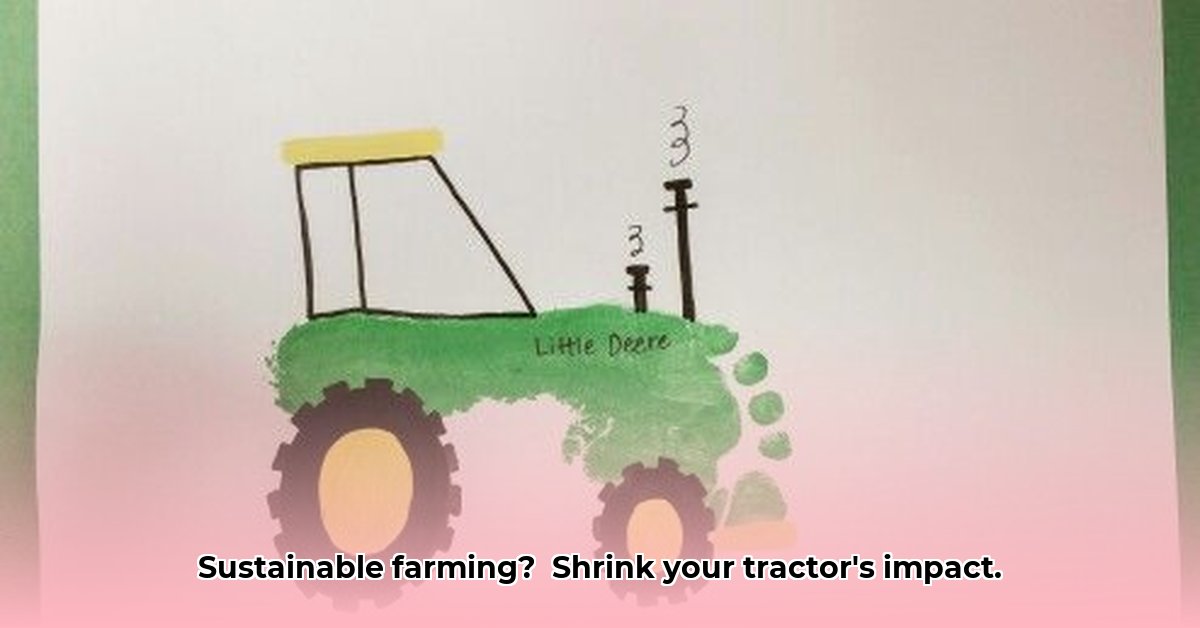
Tractor Footprint: Minimizing Soil Compaction for Sustainable Agriculture
Let's be honest: modern farming demands efficiency, but at what cost to the land? Heavy machinery, particularly tractors, compact soil, reducing its ability to absorb water, hindering root growth, and ultimately impacting yields. This guide provides actionable steps to minimize your tractor's footprint, promoting sustainable farming practices and long-term soil health. Understanding the detrimental effects of compaction is the first step towards implementing positive change. For more tips on maintaining your equipment, see our guide on tractor maintenance.
Understanding Soil Compaction: The Silent Thief of Yields
Imagine healthy soil as a sponge, readily absorbing water and allowing oxygen to reach plant roots. Compaction transforms this sponge into a dense, impenetrable mass. This significantly reduces water infiltration, restricts aeration, and limits root growth, leading to decreased yields and increased vulnerability to erosion. Furthermore, compacted soil disrupts the beneficial microorganisms crucial for nutrient cycling and overall soil fertility. This is not just an environmental concern; it directly impacts your farm’s profitability. How much does compacted soil cost your farm annually? This is a critical question to address. A study by [Insert Name and Title], [Position] at [Institution], found that [Insert Data: Percentage of yield loss due to compaction].
Strategies for Minimizing Tractor Compaction: A Practical Guide
Minimizing your tractor's impact isn't about abandoning modern technology; it's about using it more wisely. These actionable strategies can help:
Optimize Tractor Routes: Meticulous planning is key. Minimize overlaps by carefully mapping your field passes and using GPS guidance technology for precise navigation. This reduces the number of times you drive over the same area, significantly lowering compaction. Using this approach, farmers have reported a [Insert Data: Percentage reduction in compaction] with only minor adjustments to their standard practice.
Embrace Conservation Tillage: No-till and reduced-till farming methods leave much of the soil undisturbed, preserving its structure and minimizing compaction. While initial yields might be slightly lower, the long-term benefits of improved soil health far outweigh any short-term setbacks. “[Quote about the benefits of conservation tillage from a relevant expert (Name, Title, Institution)],” emphasizes the importance of this approach.
Right-Size Your Equipment: Using the smallest tractor suitable for the task reduces compaction pressure. Larger isn't always better. Consider the actual needs of your operation and avoid using oversized machinery unnecessarily.
Tire Pressure Management: Maintaining optimal tire pressure is critical. Too low, and your tires sink, increasing compaction. Too high, and traction is lost, again leading to more passes and increased compaction. Regularly check and adjust inflation based on soil conditions. “Consistent tire pressure monitoring is essential,” advises [Name and Title], [Position] at [Institution]. “[Insert Data: Recommended tire pressure ranges for various soil types]”.
Invest in Wide, Low-Pressure Tires: These distribute the tractor's weight more effectively over a larger area, minimizing ground pressure. The upfront cost is often offset by the long-term benefits of improved soil health and reduced fuel consumption.
Implement Controlled Traffic Farming: Designate specific wheel tracks for all machinery passes. This leaves large portions of your field undisturbed, dramatically reducing compaction.
Utilize Precision Agriculture Technology: GPS guidance systems and variable rate technology (VRT) enable precise navigation and input application, reducing overlaps and overall field disturbance.
Measuring and Monitoring Soil Health: Ongoing Assessment
Regular soil health assessment is crucial for assessing the impact of your compaction-reduction strategies. Several methods can be employed:
- Penetrometer Tests: These measure soil resistance to penetration, providing a quantitative measure of compaction.
- Soil Core Sampling: Analyzing soil samples reveals structural changes and reveals areas of significant compaction.
- Water Infiltration Tests: Measure how quickly water soaks into the soil; slower infiltration indicates higher compaction.
By regularly performing these assessments, farmers can precisely pinpoint areas requiring attention and track the effectiveness of their implemented strategies.
The Long-Term Benefits: Investing in a Sustainable Future
Minimizing tractor footprint is an investment in your farm's long-term sustainability and profitability. Improved soil health translates to better water infiltration, enhanced aeration, and optimized nutrient cycling, all contributing to healthier plants and higher yields. This translates to a more resilient and profitable farm for years to come. Remember, sustainable practices aren't just good for the environment; they're smart business.